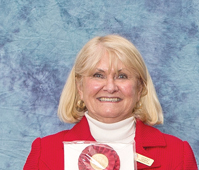IMHO – Judges Talk About Current Issues in the Sport
Click here to read the complete article
90 – September 2019
We asked experienced AKC judges two questions about current issues affecting our sport.
The Questions:
1. Describe how judging a large entry at a specialty is different than judging at an all breed show.
2. Explain how you make your “cuts” when you judge large entry specialties.
Here’s what they had to say…
 Ms. Debra Thornton – AKC Judge
Ms. Debra Thornton – AKC Judge
Describe how judging a large entry at a specialty is different than judging at an all breed show.
At an all-breed show, there won’t be the same number of dogs entered. At specialties, the numbers can be three or four times the dogs entered at an all breed show. At an all breed show, (most of the time) the entries don’t need to be cut into sections. However, sometimes there are more dogs in the ring than can easily go around the ring without running into each other. In those instances, I usually take part of the dogs out of the ring and then work with the smaller group. Depending on the number of dogs present, I may or may not make cuts.
The other item that isn’t part of an all breed show are the AOM’s. These Award of Merits are not given at an ordinary all-breed show.
Explain how you make your “cuts” when you judge large entry specialties.
It is wonderful to see all those dogs in each class. I like to split the classes into approximately 10 dogs per section. This allows me to go over each dog and keep those that I want to see again. I always keep 5 dogs from the first group and do as I want with the rest of the groups. I see no purpose in keeping dogs that I am not going to use. As an exhibitor, I appreciate being able to relax if I am not in contention for an award. I may be disappointed, but I can relax!
Once I make my cuts, then it is time to evaluate each dog in more detail. This can be hard but, at the same time, the crème usually rises to the top. There may be one, two or more that catch my eye. After I have determined which dogs that I would like to consider, I want to see them go around the ring together; usually a few dogs at a time. I usually place my top contenders together to see them move. This allows me to watch reach and drive between them as well as toplines, etc. This may be a couple of times around the ring or more. At a specialty, I believe the exhibitors enjoy showing their dogs to the crowd that is watching, as well as showcasing their dog. At that time I place my class. It makes it exciting for everyone, even the dogs!
And as I mentioned above, we need to add AOM dogs in addition to the Selects. This allows for more dogs to be recognized. I love this aspect of specialties. There are usually many nice dogs and it helps recognize all the hard work from breeders and owners alike.
 Ms. Marjorie Martorella – AKC Judge
Ms. Marjorie Martorella – AKC Judge
Describe how judging a large entry at a specialty is different than judging at an all breed show.
There are many things you have to take into consideration when judging a large entry at a specialty. Whether the show is indoors or outside will play a part in the management of the ring. The specials class at a specialty is one where you need to coordinate with your stewards as to how you want to bring the dogs in the ring initially and divide the class. I like to count the number of male and female specials and try to make cuts of 8-10 dogs. As the dogs are entering the ring to be checked in, the steward can tell them which group they are assigned to.
I think the easiest way to check the dogs in is to have them enter individually for the number to be checked and exit from another entrance. I have found this most useful, especially in outdoor shows where the weather is either hot or wet. It isn’t fair to have the dogs out in the sun wilting while the judge checks in all of the dogs and non-regular classes. Most large entry specialties would not have enough shade or cover for all of the dogs eligible for Best of Breed.
At many large specialties, and especially Nationals, the judge needs to know how many Awards of Merit are being offered. After you have decided on your BOB & BOS, you need to decide on the Selects and the Awards of Merit. The exhibitors at a National take these wins very seriously and these awards should be carefully considered. I like to have the dogs down to the last AOM in the line of order.
At an outdoor show, while I am judging the individual dogs, I want to make sure that the rest of the class is in the shade and able to be kept comfortable.
Explain how you make your “cuts” when you judge large entry specialties.
When I evaluate a dog, the first thing I look for is balance and the correct outline for the breed. I like to see them move and see if the dog keeps the outline. I would cut the dogs that are most balanced with the essential characteristics of the breed. If the specials have been divided into several groups, I usually cut no more than four in each group. From these exhibits, I would try to find the best of the best.
Describe how judging a large entry at a specialty is different than judging at an all breed show.
Usually very large entries–such as a National Specialty–will have a ring size appropriate for judging the breed. All breed shows may require more effort in managing ring congestion.
The number of quality dogs is usually higher so you will likely get further into the nuances of the breed. In a large entry specialty there is high likelihood that Awards of Merit are involved, sometimes as many as 10 or more plus the 4 normal awards. You must keep an appropriate number for all of the awards and usually place them in order. At all breed shows, the competition is normally not as fierce as at large specialties. It’s easier to judge when you are awarding the usual 4 awards.
Explain how you make your “cuts” when you judge large entry specialties.
At large entry specialties, dogs enter the ring in groups of appropriate size for the ring. Cuts are made in each group. Depending on the number of groups, additional cuts may be required. At the final cut there should be the BOB, BOS, 2 Selects, and all of the potential Award of Merit Winners plus some number that are still under consideration or may be needed in the event that a dog previously under consideration for an award can’t be considered because of limping or behavior.
At all breed shows, the breed is separated into groups that are a manageable size for the ring. Cuts are made depending on size of the entry. I usually make a cut to 3 males and 3 females for final competition, leaving the extras for reasons described above.
Click here to read the complete article
90 – September 2019
Short URL: http://caninechronicle.com/?p=172361
Comments are closed













